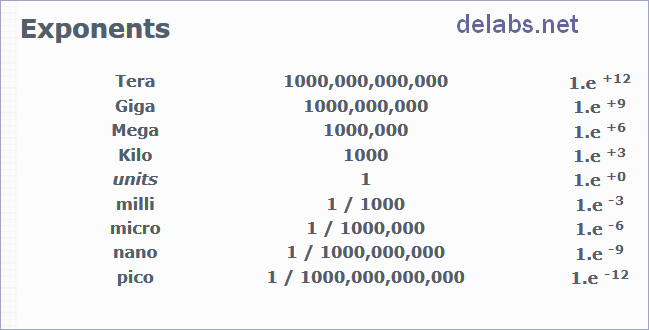Exponents - Giga Tera Pico Nano
Posted by dapj20 on Aug 14, 2014 in Basic-Tables
In the Metric System you will encounter prefixes for numbers. In electronics, right from resistors to hard disks these units are used. So you have to have in your memory, at least the ones below, so that you place the correct value of cap or inductor in your circuit.
See SI Units or Metric Units to read more about these. R, C and L values are given these prefixes.
We have resistors like 10 Tera Ohms of Glass Surface Resistance to 1 Micro Ohms of a Small Copper Wire Resistance.
1 Pico Farad of Capacitance of two Large PCB Tracks in a Multi Layer PCB to 10 Milli Farad of a Huge Electrolytic Power Supply Filter.
Then Lastly 10 Nano Henrys Inductance of the Twisted Connector Cables in a Computer and 1 Henry of a Powerful Choke that can kickback 10 Kilo Volts when a 10 Amps current thru it is broken.

Electronic Tables and Charts - Electronics is Fun, is it Not.
Most MFR Resistors have a Temperature Coefficient of 100 ppm/°C. 100ppm is like 0.01%.
0.01% is close to the resolution of a 4-1/2 Digit Voltmeter. 100.00 is the reading you will see for 100 Volts. Imagine the front end attenuator in that voltmeter is Standard MFR and a "Hot" Voltage Regulator is leaning on it, (you wanted to make your pcb compact) The last digit will be Spinning like a Ferris Wheel. Are we understanding Instrumentation!
See SI Units or Metric Units to read more about these. R, C and L values are given these prefixes.
We have resistors like 10 Tera Ohms of Glass Surface Resistance to 1 Micro Ohms of a Small Copper Wire Resistance.
1 Pico Farad of Capacitance of two Large PCB Tracks in a Multi Layer PCB to 10 Milli Farad of a Huge Electrolytic Power Supply Filter.
Then Lastly 10 Nano Henrys Inductance of the Twisted Connector Cables in a Computer and 1 Henry of a Powerful Choke that can kickback 10 Kilo Volts when a 10 Amps current thru it is broken.

Electronic Tables and Charts - Electronics is Fun, is it Not.
Most MFR Resistors have a Temperature Coefficient of 100 ppm/°C. 100ppm is like 0.01%.
0.01% is close to the resolution of a 4-1/2 Digit Voltmeter. 100.00 is the reading you will see for 100 Volts. Imagine the front end attenuator in that voltmeter is Standard MFR and a "Hot" Voltage Regulator is leaning on it, (you wanted to make your pcb compact) The last digit will be Spinning like a Ferris Wheel. Are we understanding Instrumentation!
